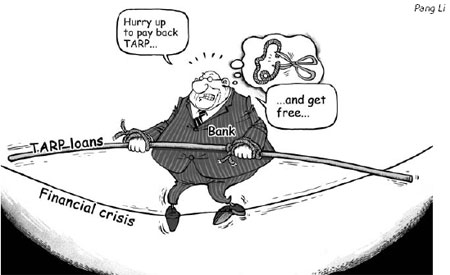
|
OPINION> OP-ED CONTRIBUTORS
 |
|
Time for investment overseas
By Zhang Monan (China Daily)
Updated: 2009-06-22 07:49 China has a golden opportunity to push forward its foreign direct investment (FDI) strategy despite the global economic slowdown. The country's performance, over the past one year, has surpassed some other major economies. Statistics show that China's total FDI outflow volume was as high as $53.4 billion last year - nearly twice as much as in 2007. This sharp rise is in stark contrast with the world's 20 percent decline in FDI. Of the total, $40.65 billion went to non-financial investment - 64 percent higher than the previous year. This year, the country's FDI is likely to exceed the use of the foreign capital invested in China. China's accelerated outward investment steps have been largely based on its strategy for a new global industrial redistribution as well as lowering exchange rate risk and reducing excessive dependence on US treasury bonds. The move is expected to help push the country's much-needed economic structural transformation, accelerate its development from being a trade power to a capital one, and sharpen its edge in the world's ever-increasing capital competition. The "China manufacturing" era will come to an end and a "China ownership" one is beginning, as some foreign media put it. The world's investment experiences indicate that a country will inevitably accelerate its outward investment strategy when its economic development reaches a certain stage, meaning a per capita gross national product (GNP) of $2,000 to $4,740. The key to pushing such a move is to increase the returns on its foreign investment and cultivate its capital competition advantages. According to the Swiss National Bank data, China's per capita GNP (in terms of real purchasing power) was $4,610 in 2007, a universally recognized stage for expediting its outward capital venture. As an export-driven economy, it is also high time that the world's third largest economy phased out its extensive trade surplus to optimize its industrial structure in the long run. In the context of a global economic recession and dwindling external demands, China's export has suffered enormously and its foreign trade environment continues to worsen. In April, the country's trade volume declined 22.8 percent year on year, with its import and export also down 1.9 and 2.1 percentage points respectively from March. It is expected that the world's total trade volumes would drop 8 percent this year. Given its ratio to the world's trade, China's foreign trade is likely to fall 15 to 20 percent this year. The unprecedented global economic crisis has also prompted the US and European countries to reduce debts, improve deposit rates and change their consumption structures to bring down trade deficits. That will further dampen the prospect for China to continue to sustain its decades-long export growth. In addition, China's ever-improving investment system has also created favorable conditions for its home capital to go global. The country has worked out numerous policies and measures to boost its FDI. Early this year, the Ministry of Commerce promulgated a regulation on outbound investment management, encouraging investment and acquisition by domestic enterprises. The State Administration of Foreign Exchange is expected to issue a draft regulation for improving exchange management of outbound investment by domestic bodies, with the aim of simplifying procedures from approval to registration. The Ministry of Commerce is now racing against time for drafting two regulations respectively on the management of foreign labor cooperation and foreign investment cooperation. At the same time, the country has set up a series of bilateral economic and trade commissions with more than 100 countries and regions and signed 127 agreements on bilateral trade. The promulgation of these policies and documents has offered a multi-dimensional policy guarantee for expediting the country's outbound investment. China also faces an ever-improving external environment for its outward capital expansion. A series of purchase, investment and acquisition moves by China's enterprises in Europe and Australia since February have hammered home the point to many countries that a rapidly flourishing China will help pull other economies out of the crisis. Also, the strategy adopted by some transnational companies to tighten overseas investment in the context of the global crisis to ease their financial difficulties and profit decline has left room to China to launch its foreign investment moves. Despite enormous progress, China has a long way to go to emerge as an investment power. By 2008, China owned 12,000 official investment projects in more than 180 countries and regions, ranking as the world's sixth largest outbound investor. However, statistics show the country's FDI value only accounted for 5 percent of the world's total in 2007, much lower than Japan, Germany and the US. Strategy requires that China expedite internationalization of the yuan. Large-scale capital export will increase other countries' demand on the yuan and help it gain a bigger share of the international financial market. The recent yuan-based cross-border business settlements and currency swap agreements in the neighborhood will contribute to developing the yuan as a regional currency. Nevertheless, the yuan is far from becoming an international currency, which acts as a constraint on large-scale foreign investment. To develop the yuan into an international settlement currency, China has to solve a series of problems related to the settlement channel, backflow, investment and conversion. Also, a scientific market mechanism on the yuan interest and exchange rates should be set up and a risk evaluation system put in place. The author is an economics researcher with the State Information Center
 (China Daily 06/22/2009 page4) |